Carbon Nanotube Field-Effect Transistor-Based Chemical and Biological Sensors
Abstract
1. Introduction
2. Surface Functionalization of CNTs for Sensing
2.1. Covaelent Modification
2.2. Non-Covalent Modification
3. Configuration and Sensing Mechanism
3.1. General CNTFETs
3.2. Electrolyte-Gated CNTFETs
4. CNTFET-Based Chemical Sensors
4.1. Gas Sensors
| Analytes | Detection Limit | Response Time | Author | References |
|---|---|---|---|---|
| NO2 | 200 ppm | 2–10 s | Kong | [37] |
| NO2 | ppb level | Not reported | Sacco | [18] |
| NO2 | 10 ppb | Not reported | L. Valentini | [39] |
| NO2 | 125 ppt | Not reported | Kumar | [40] |
| NH3 | 1% | 1–2 min | Kong | [37] |
| Carbonyl Chloride | 630 nm/refractive index unit | Not reported | Ghodrati | [41] |
| Methanol | 1.3% | Not reported | Badhulika | [42] |
| Ethanol | 5.95% | Not reported | Badhulika | [42] |
| Ethanol | 50 ppm | Nor reported | Sean Brahim | [43] |
| Ethanol | 1.67% | Not reported | S. J. Young | [44] |
| Methyl ethyl ketone | 3% | Not reported | Badhulika | [42] |
| Nitrogen dioxide | 1 ppm | Not reported | Radouane | [45] |
| Carbon monoxide | 20 ppm | Not reported | Radouane | [45] |
| Ammonia | 1% | 0.1 s | panelF.Villalpando-Páez | [46] |
| Ammonia | 100 ppb | 15 min | Qifei Chang | [47] |
4.2. H2O2 Detection
5. CNTFET-Based Biological Sensors
5.1. Protein Detection
5.2. Cell Detection
5.3. Nucleic Acid Detection
5.4. Virus Detection
| Analytes | Detection Limit | Sensitivity | Author | References |
|---|---|---|---|---|
| H5N1 virus | 1.25 pM | 0.28 nM/nA | Vu | [93] |
| Influenza A virus | 10 μM | Not reported | Thi | [87] |
| Avian influenza virus | 1 EID50 (50% embryo infectious doses)/mL | Not reported | Yin-Ting Yeh | [95] |
| H1N1 | 180 TCID50 (50% tissue culture infective dose)/mL | Not reported | Dongjin Lee | [96] |
| Hepatitis C virus | pM level | Not reported | Tawab Dastagir | [92] |
| Dengue virus | 2 ng mL−1 | Not reported | Naimish P. Sardesai | [68] |
| M13-bacteriophage | 0.5 pM | Not reported | HS Mandal | [97] |
| Dengue virus | 0.1 µg mL−1 | Not reported | Mízia M. S. Silva | [98] |
| Hepatitis B | 0.03 ng mL−1 | Not reported | Diego G.A.Cabral | [99] |
| Hepatitis B | <1 attomole | Not reported | ShunWang | [6] |
| SARS-CoV-2 | 35 mg/L | Not reported | Rebecca L. Pinals | [100] |
| Hepatitis C | 0.7 fM | Not reported | B Zribi | [85] |
| Papilloma virus | <1 attomole | Not reported | ShunWang | [82] |
| Human papilloma virus | 130 μA/V | Not reported | Gopinath | [101] |
6. Conclusions
Author Contributions
Funding
Institutional Review Board Statement
Informed Consent Statement
Data Availability Statement
Conflicts of Interest
References
- Khamfoo, K.; Inyawilert, K.; Wisitsoraat, A.; Tuantranont, A.; Phanichphant, S.; Liewhiran, C. Formaldehyde sensor based on FSP-made AgOx-doped SnO2 nanoparticulate sensing films. Sensor. Actuat. B Chem. 2020, 309, 127705. [Google Scholar] [CrossRef]
- Nam, B.; Ko, T.-K.; Hyun, S.-K.; Lee, C. CO Sensing Properties of Chemiresistive In2O3/SnO2 Composite Nanoparticle Sensors. J. Nanosci. Nanotechno. 2020, 20, 4344–4348. [Google Scholar] [CrossRef] [PubMed]
- Sebok, D.; Dekany, I. ZnO2 nanohybrid thin film sensor for the detection of ethanol vapour at room temperature using reflectometric interference spectroscopy. Sensor. Actuat. B Chem. 2015, 206, 435–442. [Google Scholar] [CrossRef]
- Baccarin, M.; Ciciliati, M.A.; Oliveira, O.N., Jr.; Cavalheiro, E.T.; Raymundo-Pereira, P.A. Pen sensor made with silver nanoparticles decorating graphite-polyurethane electrodes to detect bisphenol-A in tap and river water samples. Mater. Sci. Eng. C 2020, 114, 110989. [Google Scholar] [CrossRef]
- Raymundo-Pereira, P.A.; Baccarin, M.; Oliveira, O.N., Jr.; Janegitz, B.C. Thin films and composites based on graphene for electrochemical detection of biologically-relevant molecules. Electroanalysis 2018, 30, 1888–1896. [Google Scholar] [CrossRef]
- Cui, J.; Zhang, J.; He, X.; Mei, X.; Wang, W.; Yang, X.; Xie, H.; Yang, L.; Wang, Y. Investigating interfacial contact configuration and behavior of single-walled carbon nanotube-based nanodevice with atomistic simulations. J. Nanopart. Res. 2017, 19, 110. [Google Scholar] [CrossRef]
- Yang, W.D.; Li, Y.D.; Wang, X. Scale-dependent dynamic-pull-in of functionally graded carbon nanotubes reinforced nanodevice with piezoelectric layer. J. Aerospace Eng. 2017, 30, 04016096. [Google Scholar] [CrossRef]
- Ni, D.; Zhang, J.; Wang, X.; Qin, D.; Li, N.; Lu, W.; Chen, W. Hydroxyl radical-dominated catalytic oxidation in neutral condition by axially coordinated iron phthalocyanine on mercapto-functionalized carbon nanotubes. Indus. Eng. Chem. R. 2017, 56, 2899–2907. [Google Scholar] [CrossRef]
- Rezaei, S.J.T.; Khorramabadi, H.; Hesami, A.; Ramazani, A.; Amani, R.; Ahmadi, R. Chemoselective reduction of nitro and nitrile compounds with magnetic carbon nanotubes-supported Pt(II) catalyst under mild conditions. Ind. Eng. Chem. Res. 2017, 56, 12256–12266. [Google Scholar] [CrossRef]
- Liu, H.; Chen, J.-G.; Wang, C.; Liu, Z.-T.; Li, Y.; Liu, Z.-W.; Xiao, J.; Lu, J. Immobilization of cyclometalated iridium complex onto multiwalled carbon nanotubes for dehydrogenation of indolines in aqueous solution. Ind. Eng. Chem. Res. 2017, 56, 11413–11421. [Google Scholar] [CrossRef]
- Dalton, A.B.; Stephan, C.; Coleman, J.N.; McCarthy, B.; Ajayan, P.M.; Lefrant, S.; Bernier, P.; Blau, W.J.; Byrne, H.J. Selective interaction of a semiconjugated organic polymer with single-wall nanotubes. J. Phys. Chem. B 2000, 104, 10012–10016. [Google Scholar] [CrossRef]
- Stobinski, L.; Tomasik, P.; Lii, C.Y.; Chan, H.H.; Lin, H.M.; Liu, H.L.; Kao, C.T.; Lu, K.S. Single-walled carbon nanotube—Amylopectin complexes. Carbohyd. Polym. 2003, 51, 311–316. [Google Scholar] [CrossRef]
- Islam, M.F.; Rojas, E.; Bergey, D.M.; Johnson, A.T.; Yodh, A.G. High weight fraction surfactant solubilization of single-wall carbon nanotubes in water. Nano Lett. 2003, 3, 269–273. [Google Scholar] [CrossRef]
- Cui, D.; Ozkan, C.S.; Ravindran, S.; Kong, Y.; Gao, H. Encapsulation of pt-labelled DNA molecules inside carbon nanotubes. Mech. Chem. Biosyst. MCB 2004, 1, 113–121. [Google Scholar] [PubMed]
- Kim, H.; Seo, J.; Seong, N.; Lee, S.; Lee, S.; Kim, T.; Hong, Y. Multidipping technique for fabrication time reduction and performance improvement of solution-processed single-walled carbon nanotube thin-film transistors. Adv. Eng. Mater. 2020, 22, 1901413. [Google Scholar] [CrossRef]
- Chen, J.; Zhang, B.; Dang, X.; Zheng, D.; Ai, Y.; Chen, H. A nanocomposite consisting of etched multiwalled carbon nanotubes, amino-modified metal-organic framework UiO-66 and polyaniline for preconcentration of polycyclic aromatic hydrocarbons prior to their determination by HPLC. Mikrochim. Acta 2020, 187, 78. [Google Scholar] [CrossRef]
- Moghaddam, S.; Ghoreishi, S.S.; Yousefi, R.; Aderang, H. Quantum simulation of a junctionless carbon nanotube field-effect transistor under torsional strain. Superlattice. Microst. 2020, 138, 106239. [Google Scholar] [CrossRef]
- Sacco, L.; Forel, S.; Florea, I.; Cojocaru, C.-S. Ultra-sensitive NO2 gas sensors based on single-wall carbon nanotube field effect transistors: Monitoring from ppm to ppb level. Carbon 2020, 157, 631–639. [Google Scholar] [CrossRef]
- Choi, Y.; Kim, J.-H.; Qian, C.; Kang, J.; Hersam, M.C.; Park, J.-H.; Cho, J.H. Gate-tunable synaptic dynamics of ferroelectric-coupled carbon-nanotube transistors. ACS Appl. Mater. Inter. 2020, 12, 4707–4714. [Google Scholar] [CrossRef]
- Sharf, T.; Wang, N.-P.; Kevek, J.W.; Brown, M.A.; Wilson, H.; Heinze, S.; Minot, E.D. Single electron charge sensitivity of liquid-gated carbon nanotube transistors. Nano Lett. 2014, 14, 4925–4930. [Google Scholar] [CrossRef]
- Lapointe, F.; Ding, J.; Lefebvre, J. Carbon Nanotube Transistors as Gas Sensors: Response differentiation using polymer gate dielectrics. ACS Appl. Poly. Mater. 2019, 1, 3269–3278. [Google Scholar] [CrossRef]
- Eberle, S.; Roman, C.; Hierold, C. Effect of varying gate distance on the threshold voltage shift in carbon nanotube field effect transistor gas sensors. Microelectron. Eng. 2018, 193, 86–90. [Google Scholar] [CrossRef]
- Jeon, M.; Choi, B.; Yoon, J.; Kim, D.M.; Kim, D.H.; Park, I.; Choi, S.-J. Enhanced sensing of gas molecules by a 99.9% semiconducting carbon nanotube-based field-effect transistor sensor. Appl. Phys. Lett. 2017, 111, 022102. [Google Scholar] [CrossRef]
- Sivasathya, S.; Thiruvadigal, D.J. Ab Initio study of carbon nanotube transistor-based gas sensor for NO2 detection. Asian J. Chem. 2013, 25, S411–S413. [Google Scholar]
- Wei, L.; Chen, H.; Wang, J.; Yuang, W.; Zhao, J.; Xu, D.; Zhang, Y. Gas Sensors based on single-walled carbon nanotube field-effect transistor. Sensor. Mater. 2014, 26, 9–17. [Google Scholar]
- Bondavalli, P.; Legagneux, P.; Pribat, D. Carbon nanotubes based transistors as gas sensors: State of the art and critical review. Sensor. Actuat. B Chem. 2009, 140, 304–318. [Google Scholar] [CrossRef]
- Delgado, K.P.; Raymundo-Pereira, P.A.; Campos, A.M.; Oloveira, O.N., Jr.; Janegitz, R.C. Ultralow cost electrochemical sensor made of potatoStarch and carbon black nanoballs to detect tetracyclinein waters and milk. Electroanalysis 2018, 30, 2153–2159. [Google Scholar] [CrossRef]
- Raymundo-Pereira, P.A.; Shimizu, F.M.; Coelho, D.; Piazzeta, M.H.; Gobbi, A.L.; Machado, S.A.; Oliveira, O.N., Jr. A nanostructured bifunctional platform for sensing of glucose biomarker in artificial saliva: Synergy in hybrid Pt/Au surfaces. Biosens. Bioelectr. 2016, 86, 369–376. [Google Scholar] [CrossRef]
- Scuratti, F.; Bonacchini, G.E.; Bossio, C.; Salazar-Rios, J.M.; Talsma, W.; Loi, M.A.; Antognazza, M.R.; Caironi, M. Real-time monitoring of cellular cultures with electrolyte-gated carbon nanotube transistors. ACS Appl. Mater. Interfaces 2019, 11, 37966–37972. [Google Scholar] [CrossRef]
- Dorfman, K.D.; Adrahtas, D.Z.; Thomas, M.S.; Frisbie, C.D. Microfluidic opportunities in printed electrolyte-gated transistor biosensors. Biomicrofluidics 2020, 14, 011301. [Google Scholar] [CrossRef]
- Tin Phan, N.; Hayakawa, R.; Kilinc, V.; Petit, M.; Yemineni, S.L.V.N.; Higuchi, M.; Raimundo, J.M.; Charrier, A.M.; Wakayama, Y. Electrolyte-gated-organic field effect transistors functionalized by lipid monolayers with tunable pH sensitivity for sensor applications. Appl. Phys. Expre. 2020, 13, 011005. [Google Scholar]
- Jo, I.Y.; Park, J.-G.; Moon, J.-H.; Jung, J.Y.; Kim, D.E.; Baeg, K.-J. Low-voltage-operating complementary-like circuits using ambipolar organic-inorganic hybrid thin-film transistors with solid-state-electrolyte gate insulator. Org. Electron. 2019, 75, 105358. [Google Scholar] [CrossRef]
- Neuper, F.; Chandresh, A.; Singaraju, S.A.; Aghassi-Hagmann, J.; Hahn, H.; Breitung, B. Tailoring threshold voltages of printed electrolyte-gated field-effect transistors by chromium doping of indium oxide channels. ACS Omega 2019, 4, 20579–20585. [Google Scholar] [CrossRef] [PubMed]
- Larrimore, L.; Nad, S.; Zhou, X.; Abruna, H.; McEuen, P.L. Probing electrostatic potentials in solution with carbon nanotube transistors. Nano Lett. 2006, 6, 1329–1333. [Google Scholar] [CrossRef] [PubMed]
- Boussaad, S.; Diner, B.A.; Fan, J. Influence of redox molecules on the electronic conductance of single-walled carbon nanotube field-effect transistors: Application to chemical and biological sensing. J. Am. Chem. Soc. 2008, 130, 3780–3787. [Google Scholar] [CrossRef]
- Shirsat, M.D.; Sarkar, T.; Kakoullis, J., Jr.; Myung, N.V.; Konnanath, B.; Spanias, A.; Mulchandani, A. Porphyrin-functionalized single-walled carbon nanotube chemiresistive sensor arrays for VOCs. J. Phys. Chem. C 2012, 116, 3845–3850. [Google Scholar] [CrossRef]
- Kong, J.; Franklin, N.R.; Zhou, C.; Chapline, M.G.; Peng, S.; Cho, K.; Dai, H. Nanotube molecular wires as chemical sensors. Science 2000, 287, 622–625. [Google Scholar] [CrossRef]
- Tans, S.J.; Verschueren, A.R.; Dekker, C. Room-temperature transistor based on a single carbon nanotube. Nature 1998, 393, 49–52. [Google Scholar] [CrossRef]
- Valentini, L.; Armentano, I.; Kenny, J.; Cantalini, C.; Lozzi, L.; Santucci, S. Sensors for sub-ppm NO2 gas detection based on carbon nanotube thin films. Appl. Phys. Lett. 2003, 82, 961–963. [Google Scholar] [CrossRef]
- Kumar, D.; Chaturvedi, P.; Saho, P.; Jha, P.; Chouksey, A.; Lal, M.; Rawat, J.S.B.S.; Tandon, R.P.; Chaudhury, P.K. Effect of single wall carbon nanotube networks on gas sensor response and detection limit. Sensor. Actuat. B Chem. 2017, 240, 1134–1140. [Google Scholar] [CrossRef]
- Ghodrati, M.; Farmani, A.; Mir, A. Nanoscale sensor-based tunneling carbon nanotube transistor for toxic gases detection: A first-principle Sstudy. IEEE Sens. J. 2019, 19, 7373–7377. [Google Scholar] [CrossRef]
- Badhulika, S.; Myung, N.V.; Mulchandani, A. Conducting polymer coated single-walled carbon nanotube gas sensors for the detection of volatile organic compounds. Talanta 2014, 123, 109–114. [Google Scholar] [CrossRef]
- Brahim, S.; Colbern, S.; Gump, R.; Moser, A.; Grigorian, L. Carbon nanotube-based ethanol sensors. ACS Sym. Ser. 2009, 20, 235502. [Google Scholar] [CrossRef] [PubMed]
- Young, S.; Lin, Z. Ethanol gas sensors based on multi-wall carbon nanotubes on oxidized Si substrate. Microsyst. Technol. 2018, 24, 55–58. [Google Scholar] [CrossRef]
- Leghrib, R.; Pavelko, R.; Felten, A.; Vasiliev, A.; Cané, C.; Gràcia, I.; Pireaux, J.-J.; Llobet, E. Gas sensors based on multiwall carbon nanotubes decorated with tin oxide nanoclusters. Sensor. Actuat. B Chem 2010, 145, 411–416. [Google Scholar] [CrossRef]
- Villalpando-Páez, F.; Romero, A.; Munoz-Sandoval, E.; Martınez, L.; Terrones, H.; Terrones, M. Fabrication of vapor and gas sensors using films of aligned CNx nanotubes. Chem. Phys. Lett. 2004, 386, 137–143. [Google Scholar] [CrossRef]
- Chang, Q.; Zhao, K.; Chen, X.; Li, M.; Liu, J. Preparation of gold/polyaniline/multiwall carbon nanotube nanocomposites and application in ammonia gas detection. J. Mater. Sci. 2008, 43, 5861–5866. [Google Scholar] [CrossRef]
- Slobodian, P.; Riha, P.; Lengálová, A.; Svoboda, P.; Sáha, P. Multi-wall carbon nanotube networks as potential resistive gas sensors for organic vapor detection. Carbon 2011, 49, 2499–2507. [Google Scholar] [CrossRef]
- Sattari, S.; Reyhani, A.; Khanlari, M.; Khabazian, M.; Heydari, H. Synthesize of polyaniline–multi walled carbon nanotubes composite on the glass and silicon substrates and methane gas sensing behavior of them at room temperature. J. Ind. Eng. Chem. 2014, 20, 1761–1764. [Google Scholar] [CrossRef]
- Zhao, J.; Buldum, A.; Han, J.; Lu, J.P. Gas molecule adsorption in carbon nanotubes and nanotube bundles. Nanotechnology 2002, 13, 195. [Google Scholar] [CrossRef]
- Woods, L.; Bădescu, Ş.; Reinecke, T. Adsorption of simple benzene derivatives on carbon nanotubes. Phys. Rev. B 2007, 75, 155415. [Google Scholar] [CrossRef]
- Dilonardo, E.; Penza, M.; Alvisi, M.; Di Franco, C.; Rossi, R.; Palmisano, F.; Torsi, L.; Cioffi, N. Electrophoretic deposition of Au NPs on MWCNT-based gas sensor for tailored gas detection with enhanced sensing properties. Sensor. Actuat. B Chem. 2016, 223, 417–428. [Google Scholar] [CrossRef]
- Peng, S.; Cho, K. Ab initio study of doped carbon nanotube sensors. Nano Lett. 2003, 3, 513–517. [Google Scholar] [CrossRef]
- Cella, L.N.; Chen, W.; Myung, N.V.; Mulchandani, A. Single-walled carbon nanotube-based chemiresistive affinity biosensors for small molecules: Ultrasensitive glucose detection. J. Am. Chem. Soc. 2010, 132, 5024–5026. [Google Scholar] [CrossRef] [PubMed]
- Joshi, S.; Bhatt, V.D.; Wu, H.; Becherer, M.; Lugli, P. Flexible lactate and glucose sensors using electrolyte-gated carbon nanotube field effect transistor for non-invasive real-time monitoring. IEEE Sens. J. 2017, 17, 4315–4321. [Google Scholar] [CrossRef]
- Pomowski, A.; Baricham, C.; Rapp, B.E.; Matern, A.; Laenge, K. Acoustic biosensors coated with phosphorylcholine groups for label-free detection of human C-reactive protein in serum. IEEE Sens. J. 2015, 15, 4388–4392. [Google Scholar] [CrossRef]
- Raina, M.; Sharma, R.; Deacon, S.E.; Tiede, C.; Tomlinson, D.; Davies, A.G.; McPherson, M.J.; Waelti, C. Antibody mimetic receptor proteins for label-free biosensors. Analyst 2015, 140, 803–810. [Google Scholar] [CrossRef][Green Version]
- Ly, S.Y.; Cho, N.S. Diagnosis of human hepatitis B virus in non-treated blood by the bovine IgG DNA-linked carbon nanotube biosensor. J. Clin. Virol. 2009, 44, 43–47. [Google Scholar] [CrossRef]
- Shao, K.; Zhang, C.; Ye, S.; Cai, K.; Wu, L.; Wang, B.; Zou, C.; Lu, Z.; Han, H. Near-infrared electrochemiluminesence biosensor for high sensitive detection of porcine reproductive and respiratory syndrome virus based on cyclodextrin-grafted porous Au/PtAu nanotube. Sensor. Actuat. B Chem. 2017, 240, 586–594. [Google Scholar] [CrossRef]
- Wasik, D.; Mulchandani, A.; Yates, M.V. A heparin-functionalized carbon nanotube-based affinity biosensor for dengue virus. Biosens. Bioelectron. 2017, 91, 811–816. [Google Scholar] [CrossRef]
- Boussaad, S.; Tao, N.J.; Zhang, R.; Hopson, T.; Nagahara, L.A. In situ detection of cytochrome c adsorption with single walled carbon nanotube device. Chem. Commun. 2003, 1502–1503. [Google Scholar] [CrossRef]
- Chao, L.; Curreli, M.; Lin, H.; Bo, L.; Zhou, C. Complementary detection of prostate-specific antigen using In2 O3 nanowires and carbon nanotubes. J. Am. Chem. Soc. 2005, 127, 12484–12485. [Google Scholar]
- Wang, C.-W.; Pan, C.-Y.; Wu, H.-C.; Shih, P.-Y.; Tsai, C.-C.; Liao, K.-T.; Lu, L.-L.; Hsieh, W.-H.; Chen, C.-D.; Chen, Y.-T. In situ detection of chromogranin a released from living neurons with a single-walled carbon-nanotube field-effect transistor. Small 2007, 3, 1350–1355. [Google Scholar] [CrossRef] [PubMed]
- Filipiak, M.S.; Rother, M.; Andoy, N.M.; Knudsen, A.C.; Grimm, S.; Bachran, C.; Swee, L.K.; Zaumseil, J.; Tarasov, A. Highly sensitive, selective and label-free protein detection in physiological solutions using carbon nanotube transistors with nanobody receptors. Sensor. Actuat. B Chem. 2018, 255, 1507–1516. [Google Scholar] [CrossRef]
- Cheng, H.; Jin, W.; Huang, X.; Liu, X.; Wang, F.; Guo, X.; Wu, Y.; Ying, Y.; Wen, Y.; Yang, H. A flexible carbon nanotube-modified poly (styrene-butadiene)-based dopamine sensor. ACS Sym. Ser. 2019, 31, 015505. [Google Scholar] [CrossRef]
- Cheng, J.; Wang, X.; Nie, T.; Yin, L.; Wang, S.; Zhao, Y.; Wu, H.; Mei, H. A novel electrochemical sensing platform for detection of dopamine based on gold nanobipyramid/multi-walled carbon nanotube hybrids. Anal. Bioanal. Chem. 2020, 412, 2433–2441. [Google Scholar] [CrossRef]
- Huang, Q.; Lin, X.; Tong, L.; Tong, Q.-X. Graphene quantum dots/multiwalled carbon nanotubes composite-based electrochemical sensor for detecting dopamine release from living cells. ACS Sustain. Chem. Eng. 2020, 8, 1644–1650. [Google Scholar] [CrossRef]
- Dias, A.C.M.; Gomes-Filho, S.L.; Silva, M.M.; Dutra, R.F. A sensor tip based on carbon nanotube-ink printed electrode for the dengue virus NS1 protein. Biosens. Bioelectr. 2013, 44, 216–221. [Google Scholar] [CrossRef]
- Sardesai, N.P.; Barron, J.C.; Rusling, J.F. Carbon nanotube microwell array for sensitive electrochemiluminescent detection of cancer biomarker proteins. Anal. Chem. 2011, 83, 6698–6703. [Google Scholar] [CrossRef]
- Ahn, J.-H.; Kim, J.-H.; Reuel, N.F.; Barone, P.W.; Boghossian, A.A.; Zhang, J.; Yoon, H.; Chang, A.C.; Hilmer, A.J.; Strano, M.S. Label-free, single protein detection on a near-infrared fluorescent single-walled carbon nanotube/protein microarray fabricated by cell-free synthesis. Nano Lett. 2011, 11, 2743–2752. [Google Scholar] [CrossRef]
- Kojima, A.; Hyon, C.K.; Kamimura, T.; Maeda, M.; Matsumoto, K. Protein sensor using carbon nanotube field effect transistor. JPN J. Appl. Phys. 2005, 44, 1596–1598. [Google Scholar] [CrossRef]
- Williams, R.M.; Lee, C.; Heller, D.A. A fluorescent carbon nanotube sensor detects the metastatic prostate cancer biomarker uPA. ACS Sensors 2018, 3, 1838–1845. [Google Scholar] [CrossRef] [PubMed]
- Villamizar, R.A.; Maroto, A.; Rius, F.X.; Inza, I.; Figueras, M.J. Fast detection of Salmonella Infantis with carbon nanotube field effect transistors. Biosens. Bioelectron. 2008, 24, 279–283. [Google Scholar] [CrossRef] [PubMed]
- So, H.M.; Park, D.W.; Jeon, E.K.; Kim, Y.H.; Kim, B.S.; Lee, C.K.; Choi, S.Y.; Kim, S.C.; Chang, H.; Lee, J.O. Detection and titer estimation of Escherichia coli using aptamer-functionalized single-walled carbon-nanotube field-effect transistors. Small 2008, 4, 197–201. [Google Scholar] [CrossRef]
- Kim, J.P.; Lee, B.Y.; Lee, J.; Hong, S.; Sim, S.J. Enhancement of sensitivity and specificity by surface modification of carbon nanotubes in diagnosis of prostate cancer based on carbon nanotube field effect transistors. Biosens. Bioelectron. 2009, 24, 3372–3378. [Google Scholar] [CrossRef]
- Martínez, M.T.; Tseng, Y.-C.; Ormategui, N.; Loinaz, I.; Eritja, R.; Bokor, J. Label-free DNA biosensors based on functionalized carbon nanotube field effect transistors. Nano Lett. 2009, 9, 530–536. [Google Scholar] [CrossRef]
- Sorgenfrei, S.; Chiu, C.-Y.; Gonzalez, R.L., Jr.; Yu, Y.-J.; Kim, P.; Nuckolls, C.; Shepard, K.L. Label-free single-molecule detection of DNA-hybridization kinetics with a carbon nanotube field-effect transistor. Nat. Nanotechnol. 2011, 6, 126–132. [Google Scholar] [CrossRef]
- Ramnani, P.; Gao, Y.; Ozsoz, M.; Mulchandani, A. Electronic detection of microRNA at attomolar level with high specificity. Anal. Chem. 2013, 85, 8061–8064. [Google Scholar] [CrossRef]
- Kurkina, T.; Vlandas, A.; Ahmad, A.; Kern, K.; Balasubramanian, K. Label-free detection of few copies of DNA with carbon nanotube impedance biosensors. Angewandte Chem. Int. Ed. 2011, 50, 3710–3714. [Google Scholar] [CrossRef]
- Stine, R.; Robinson, J.T.; Sheehan, P.E.; Tamanaha, C.R. Real-time DNA detection using reduced graphene oxide field effect transistors. Adv. Mater. 2010, 22, 5297–5300. [Google Scholar] [CrossRef]
- Cai, B.; Wang, S.; Huang, L.; Ning, Y.; Zhang, Z.; Zhang, G.-J. Ultrasensitive label-free detection of PNA-DNA hybridization by reduced graphene oxide field-effect transistor biosensor. ACS Nano 2014, 8, 2632–2638. [Google Scholar] [CrossRef] [PubMed]
- Wang, S.; Li, L.; Jin, H.; Yang, T.; Bao, W.; Huang, S.; Wang, J. Electrochemical detection of hepatitis B and papilloma virus DNAs using SWCNT array coated with gold nanoparticles. Biosens. Bioelectr. 2013, 41, 205–210. [Google Scholar] [CrossRef] [PubMed]
- Yin, Z.; He, Q.; Huang, X.; Zhang, J.; Wu, S.; Chen, P.; Lu, G.; Chen, P.; Zhang, Q.; Yan, Q.; et al. Real-time DNA detection using Pt nanoparticle-decorated reduced graphene oxide field-effect transistors. Nanoscale 2012, 4, 293–297. [Google Scholar] [CrossRef] [PubMed]
- Tam, P.D.; Van Hieu, N.; Chien, N.D.; Le, A.-T.; Tuan, M.A. DNA sensor development based on multi-wall carbon nanotubes for label-free influenza virus (type A) detection. J. Immun. Methods 2009, 350, 118–124. [Google Scholar] [CrossRef] [PubMed]
- Zribi, B.; Roy, E.; Pallandre, A.; Chebil, S.; Koubaa, M.; Mejri, N.; Magdinier Gomez, H.; Sola, C.; Korri-Youssoufi, H.; Haghiri-Gosnet, A.-M. A microfluidic electrochemical biosensor based on multiwall carbon nanotube/ferrocene for genomic DNA detection of Mycobacterium tuberculosis in clinical isolates. Biomicrofluidics. 2016, 10, 014115. [Google Scholar] [CrossRef]
- Qiu, W.; Xu, H.; Takalkar, S.; Gurung, A.S.; Liu, B.; Zheng, Y.; Guo, Z.; Baloda, M.; Baryeh, K.; Liu, G. Carbon nanotube-based lateral flow biosensor for sensitive and rapid detection of DNA sequence. Biosens. Bioelectr. 2015, 64, 367–372. [Google Scholar] [CrossRef]
- Star, A.; Tu, E.; Niemann, J.; Gabriel, J.-C.P.; Joiner, C.S.; Valcke, C. Label-free detection of DNA hybridization using carbon nanotube network field-effect transistors. Proc. Natl. Acad. Sci. 2006, 103, 921–926. [Google Scholar] [CrossRef]
- Dong, X.; Lau, C.M.; Lohani, A.; Mhaisalkar, S.G.; Kasim, J.; Shen, Z.; Ho, X.; Rogers, J.A.; Li, L.J. Electrical detection of femtomolar DNA via gold-nanoparticle enhancement in carbon-nanotube-network field-effect transistors. Adv. Mater. 2008, 20, 2389–2393. [Google Scholar] [CrossRef]
- Maehashi, K.; Matsumoto, K.; Kerman, K.; Takamura, Y.; Tamiya, E. Ultrasensitive detection of DNA hybridization using carbon nanotube field-effect transistors. JPN J. Appl. Phys. 2004, 43, L1558. [Google Scholar] [CrossRef]
- Zheng, C.; Huang, L.; Zhang, H.; Sun, Z.; Zhang, Z.; Zhang, G.-J. Fabrication of ultrasensitive field-effect transistor DNA biosensors by a directional transfer technique based on CVD-grown graphene. ACS Appl. Mater. Inter. 2015, 7, 16953–16959. [Google Scholar] [CrossRef]
- Tran, T.L.; Nguyen, T.T.; Tran, T.T.H.; Chu, V.T.; Tran, Q.T.; Mai, A.T. Detection of influenza A virus using carbon nanotubes field effect transistor based DNA sensor. Phys. E Low Dimens. Syst. Nanostr. 2017, 93, 83–86. [Google Scholar] [CrossRef]
- Dastagir, T.; Forzani, E.S.; Zhang, R.; Amlani, I.; Nagahara, L.A.; Tsui, R.; Tao, N. Electrical detection of hepatitis C virus RNA on single wall carbon nanotube-field effect transistors. Analyst 2007, 132, 738–740. [Google Scholar] [CrossRef] [PubMed]
- Thu, V.V.; Tam, P.D.; Dung, P.T. Rapid and label-free detection of H5N1 virus using carbon nanotube network field effect transistor. Curr. Appl. Phys. 2013, 13, 1311–1315. [Google Scholar] [CrossRef]
- Fatin, M.F.; Rahim Ruslinda, A.; Gopinath, S.C.B.; Arshad, M.K.M. High-performance interactive analysis of split aptamer and HIV-1 Tat on multiwall carbon nanotube-modified field-effect transistor. Inter. J. Bio. Macromol. 2019, 125, 414–422. [Google Scholar] [CrossRef]
- Yeh, Y.-T.; Tang, Y.; Sebastian, A.; Dasgupta, A.; Perea-Lopez, N.; Albert, I.; Lu, H.; Terrones, M.; Zheng, S.-Y. Tunable and label-free virus enrichment for ultrasensitive virus detection using carbon nanotube arrays. Sci. Adv. 2016, 2, e1601026. [Google Scholar] [CrossRef]
- Lee, D.; Chander, Y.; Goyal, S.M.; Cui, T. Carbon nanotube electric immunoassay for the detection of swine influenza virus H1N1. Biosens. Bioelectr. 2011, 26, 3482–3487. [Google Scholar] [CrossRef]
- Mandal, H.S.; Su, Z.; Ward, A.; Tang, X.S. Carbon nanotube thin film biosensors for sensitive and reproducible whole virus detection. Theranostics 2012, 2, 251–257. [Google Scholar] [CrossRef]
- Silva, M.M.; Dias, A.C.; Silva, B.V.; Gomes-Filho, S.L.; Kubota, L.T.; Goulart, M.O.; Dutra, R.F. Electrochemical detection of dengue virus NS1 protein with a poly (allylamine)/carbon nanotube layered immunoelectrode. J. Chem. Technol. Biotechnol. 2015, 90, 194–200. [Google Scholar] [CrossRef]
- Cabral, D.G.; Lima, E.C.; Moura, P.; Dutra, R.F. A label-free electrochemical immunosensor for hepatitis B based on hyaluronic acid–carbon nanotube hybrid film. Talanta 2016, 148, 209–215. [Google Scholar] [CrossRef]
- Pinals, R.L.; Ledesma, F.; Yang, D.; Navarro, N.; Jeong, S.; Pak, J.E.; Kuo, L.; Chuang, Y.-C.; Cheng, Y.-W.; Sun, H.-Y. Rapid SARS-CoV-2 Detection by Carbon Nanotube-Based Near-Infrared Nanosensors. medRxiv 2020. [Google Scholar] [CrossRef]
- Gopinath, P.G.; Anitha, V.R.; Mastani, S.A. Design of biosensor array with current boost and signal conditioning circuits for HPV detection. Alexa. Eng. J. 2018, 57, 671–681. [Google Scholar] [CrossRef]
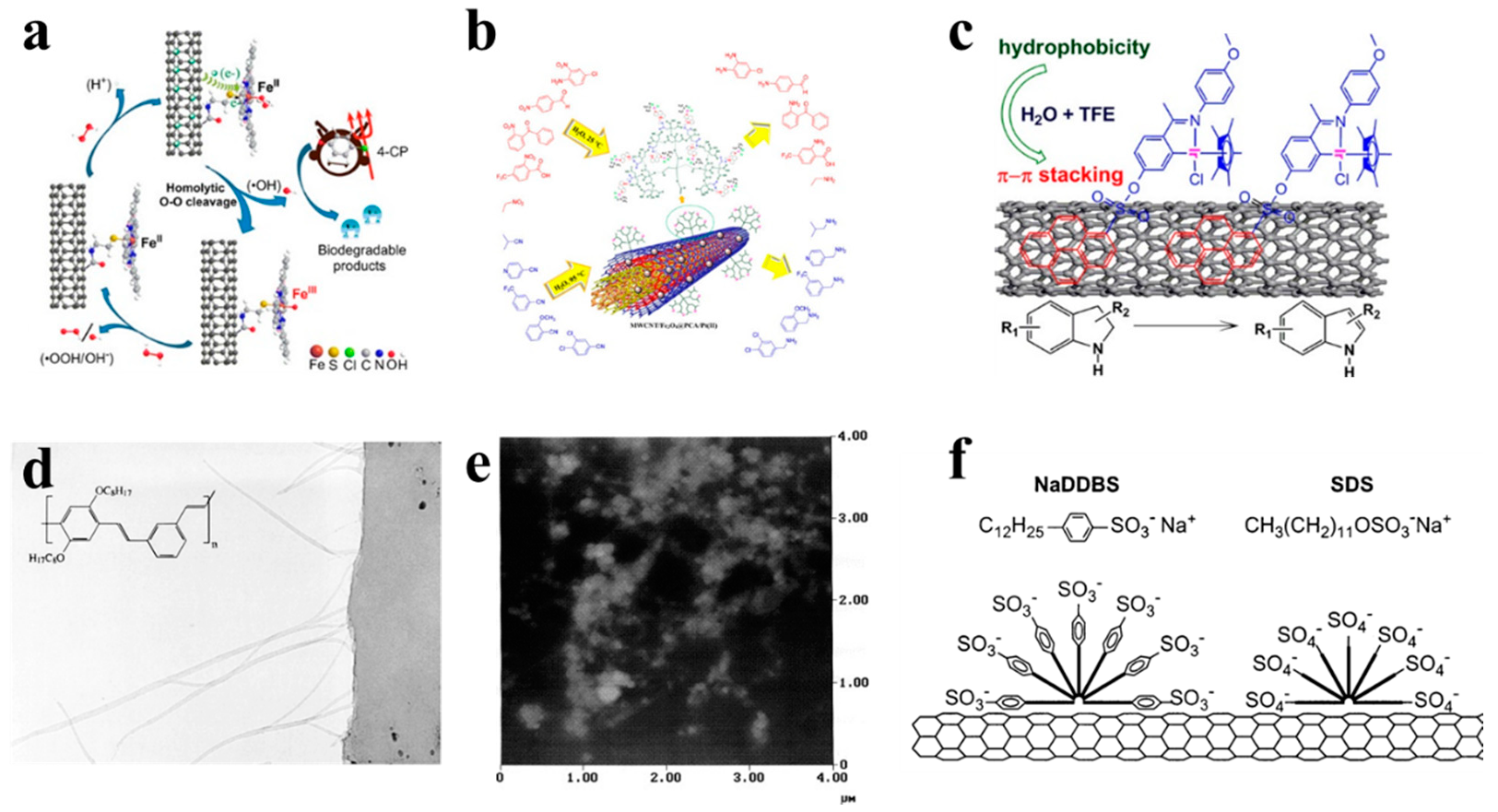
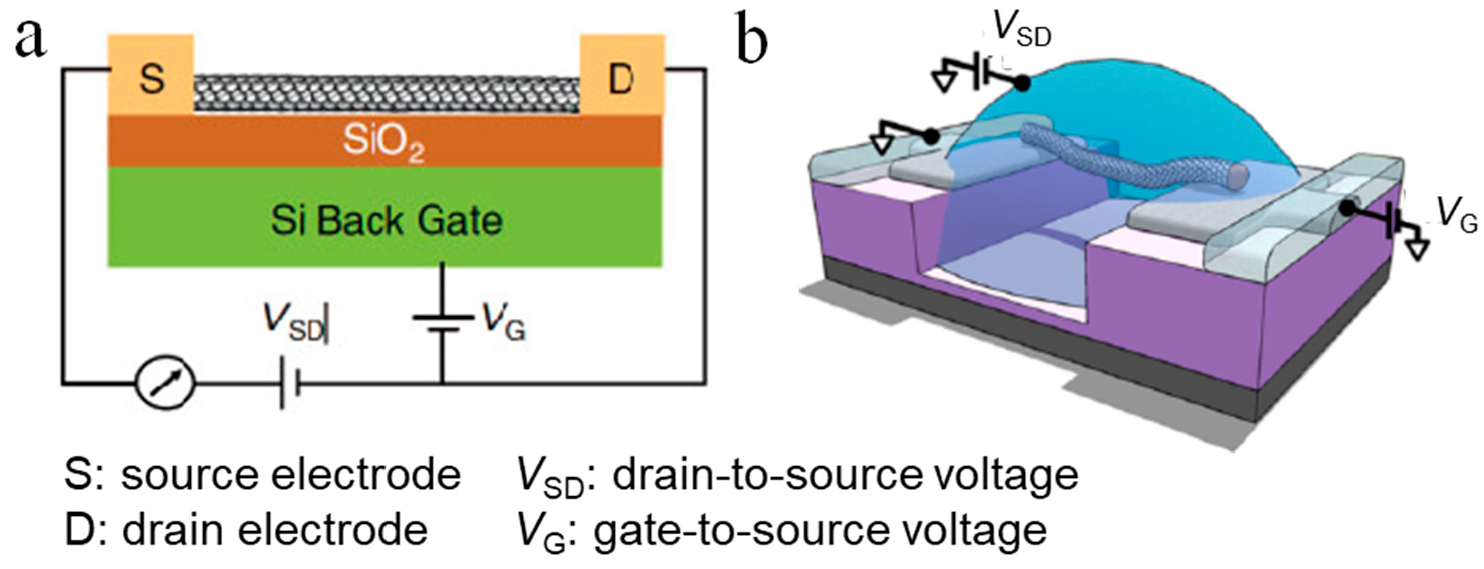
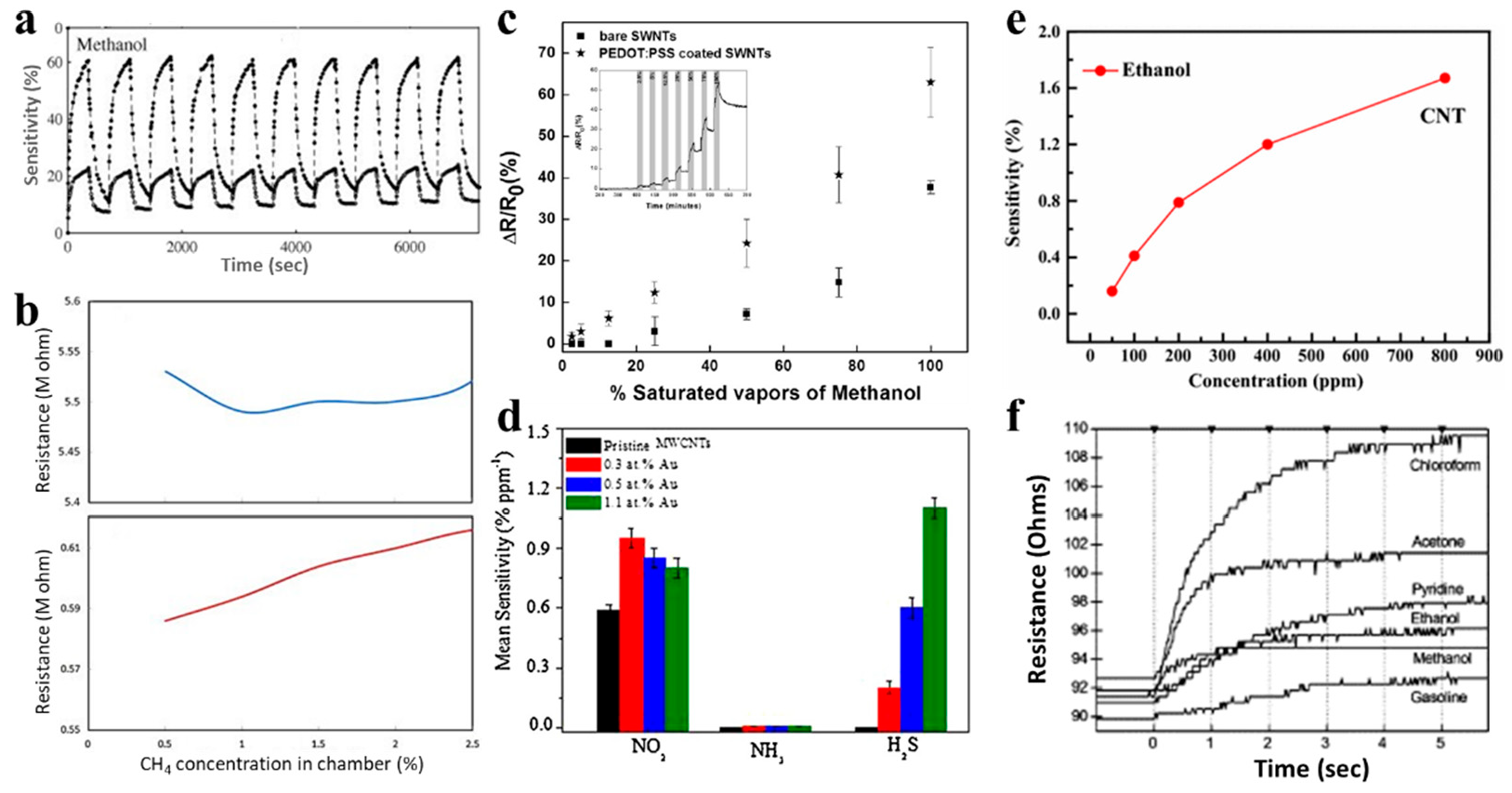



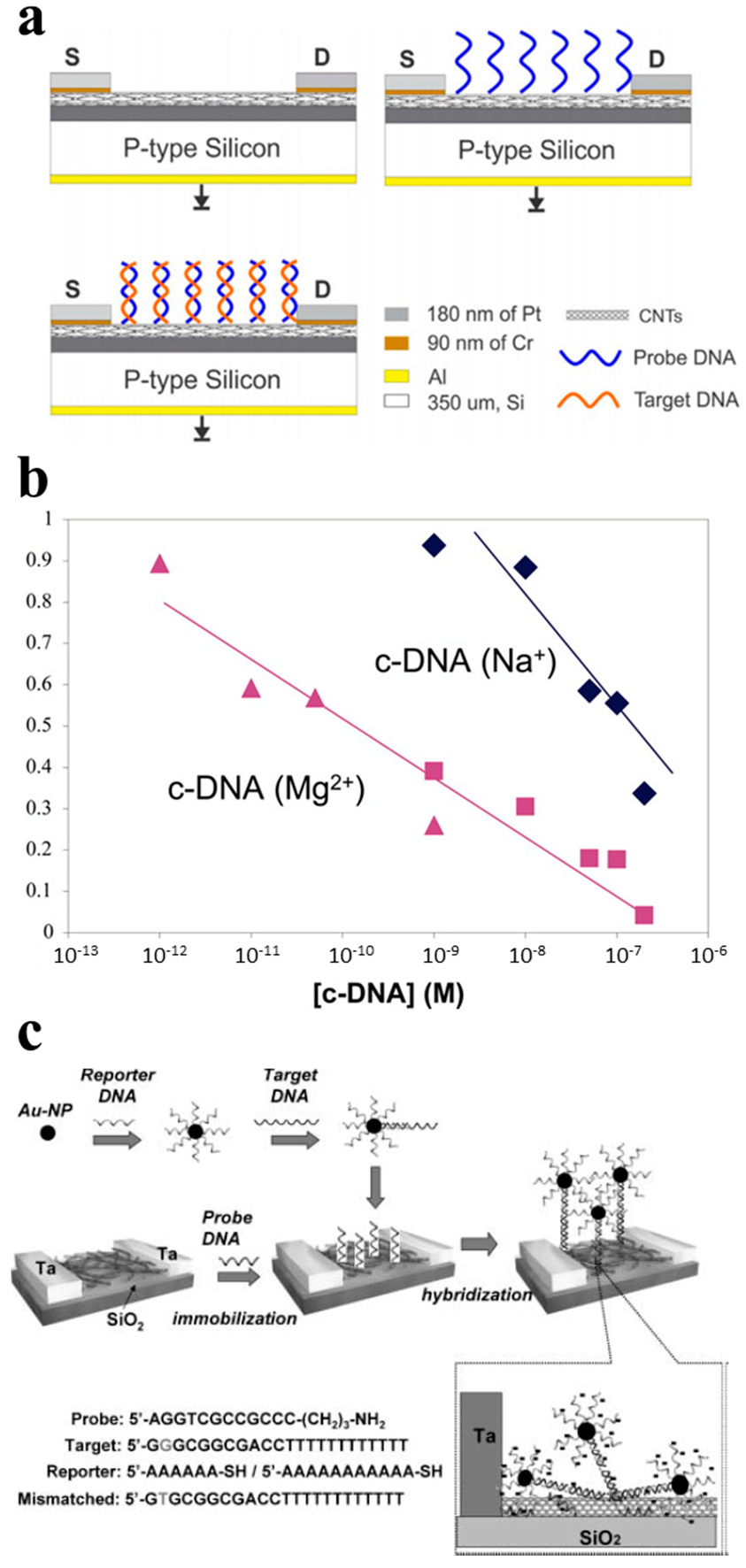
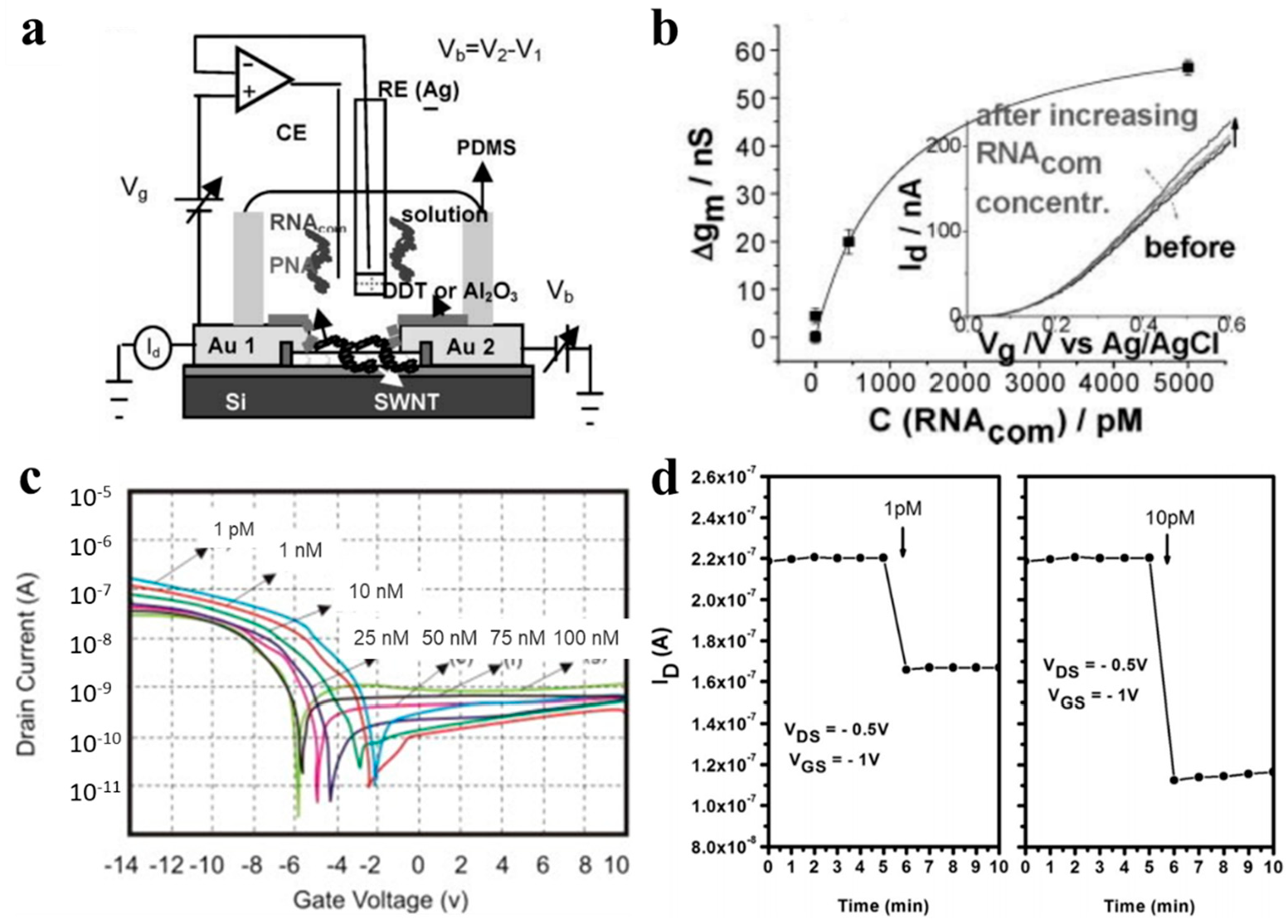
| Analytes | Detection Limit | Sensitivity | Author | References |
|---|---|---|---|---|
| Dopamine | 0.062 μM | Not reported | Haiyan Cheng | [65] |
| Dopamine | 15 nM | Not reported | Jinyan Cheng | [66] |
| Dopamine | 0.87 nM | Not reported | Qitong Huang | [67] |
| Specific protein detection | 0.1 pM | Not reported | Marcin | [64] |
| Non-structural protein 1 of the dengue virus | 2 ng/mL | Not reported | sAna Carolina M.S.Dias | [68] |
| Prostate specific antigen | 1 pg/mL | Not reported | Naimish P. Sardesai | [69] |
| IL-6 | 0.25 pg/ mL | Not reported | Naimish P. Sardesai | [69] |
| Hexahistidine-tagged capture proteins | 10 pM | 600 s | Jin-Ho Ahn | [70] |
| Pig serum albumin | 2.06 µmol/L | Not reported | Atsuhiko Kojima | [71] |
| Urokinase plasminogen activator | 25 nM | Not reported | Ryan M. Williams | [72] |
| Analytes | Receptors | Detection Limit | Author | References |
|---|---|---|---|---|
| 12-mer ssRNA | 12-mer PNA | Not Reported | Martínez | [76] |
| 10-mer ssDNA | 10-mer ssDNA probe | Single molecule | Sorgenfrei | [77] |
| microRNA-122a | p19 protein | 1 aM | Ramnani | [78] |
| DNA | Amino-functionalized probe DNA | Attomolar level | Tetiana Kurkina | [79] |
| ssDNA | ssDNA probe | 2 nM | Stine | [80] |
| ssDNA | Peptide nucleic acid probe | 100 fM | Cai | [81] |
| ssDNA | ssDNA probe | <1 attomole. | ShunWang | [82] |
| ssDNA | ssDNA probe | <1 attomole. | ShunWang | [82] |
| ssDNA | ssDNA probe | 2.4 nM | Yin | [83] |
| ssDNA | ssDNA probe | 0.5 nM | Phuong DinhTam | [84] |
| ssDNA | ssDNA probe | 0.7 fM | B Zribi | [85] |
| ssDNA | Amine-modified DNA detection probe | 0.1 nM | Wanwei Qiu | [86] |
| ssDNA | ssDNA | 1 pM | Alexander Star | [87] |
| ssDNA | ssDNA | 100 fM | Xiaochen Dong | [88] |
| ssDNA | Amino modified PNA | 6.8 fM | Kenzo Maehashi | [89] |
| ssDNA | Peptide nucleic acid probe | 10 fM | Zheng | [90] |
Publisher’s Note: MDPI stays neutral with regard to jurisdictional claims in published maps and institutional affiliations. |
© 2021 by the authors. Licensee MDPI, Basel, Switzerland. This article is an open access article distributed under the terms and conditions of the Creative Commons Attribution (CC BY) license (http://creativecommons.org/licenses/by/4.0/).
Share and Cite
Yao, X.; Zhang, Y.; Jin, W.; Hu, Y.; Cui, Y. Carbon Nanotube Field-Effect Transistor-Based Chemical and Biological Sensors. Sensors 2021, 21, 995. https://doi.org/10.3390/s21030995
Yao X, Zhang Y, Jin W, Hu Y, Cui Y. Carbon Nanotube Field-Effect Transistor-Based Chemical and Biological Sensors. Sensors. 2021; 21(3):995. https://doi.org/10.3390/s21030995
Chicago/Turabian StyleYao, Xuesong, Yalei Zhang, Wanlin Jin, Youfan Hu, and Yue Cui. 2021. "Carbon Nanotube Field-Effect Transistor-Based Chemical and Biological Sensors" Sensors 21, no. 3: 995. https://doi.org/10.3390/s21030995
APA StyleYao, X., Zhang, Y., Jin, W., Hu, Y., & Cui, Y. (2021). Carbon Nanotube Field-Effect Transistor-Based Chemical and Biological Sensors. Sensors, 21(3), 995. https://doi.org/10.3390/s21030995






